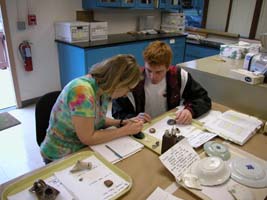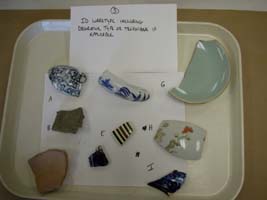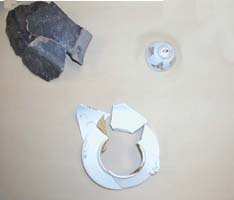My name is Bryn Williams, and I am the teaching assistant for the laboratory methods class this year. When I took the course as a student last year I knew that Professor Voss and Ezra (the previous TA) did quite a bit of work behind the scenes to prepare for the course, but I never knew exactly what they did. For every hour of class there are at least two hours of preparation. Artifact catalog sheets need to be printed, the ceramics artifacts we are having the students catalog need to be rough-sorted into feature numbers, supplies need to be ordered, the artifact database needs to be checked, and these are just some of the tasks from the first two weeks. Being a TA for this course is giving me an inside view of the kind of work involved in running an archaeology lab. Even though there has been a lot of work, it has all been fun and productive. Being a TA for this project has only increased my interest in the Market Street site in particular, and the archaeological process in general.
It is only the second week of lab methods class, and the students have already started to catalog ceramic artifacts from the 86-36 collection. We began the week on Tuesday with a lecture on ceramics. Professor Voss briefly discussed how ceramics are made and decorated, and then went into detail about the different ceramics we are likely to encounter in the 86-36 collection. On Thursday the students in the class put concepts from the Tuesday lecture into practice. Professor Voss and I set up trays of ceramics for students to work with. Some of the trays asked the students to identify the types of ceramics on the tray, others displayed ceramics with makers marks and asked the students to identify those makers marks using reference books in the lab. An example of one of the trays is in the picture above and to the left. See if you can identify any of the artifacts. The students did exceptionally well on these tests, and by Friday we were ready to start the analysis of ceramics from the 86-36 collection. (The answers to the tray are: A)Porcelain, “double happiness” decoration; B) Stoneware, molded relief decoration; C) Earthenware, slipped and burnished; D) Ironstone, transfer print decoration; E) Pearlware, annular decoration; F) Whiteware, flow blue transfer print; G) Porcelain, celadon decoration; H) Porcelain, “4 seasons” decoration; I) Tin-Glazed earthenware; hand painted.)
Featured Artifact
The artifacts of the week are three artifacts that were cataloged by the students in CASA 103/203. They illustrate the diversity of the collections that we will be analyzing. Despite this diversity in form, decoration, and function; the students in the course were able to successfully identify these artifacts, fill out their catalog forms, and enter the data into the computerized database.


